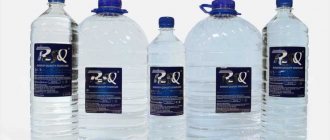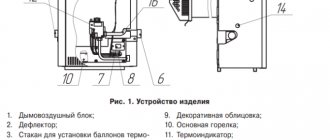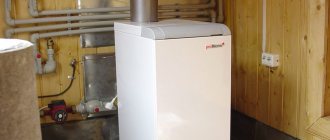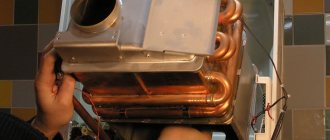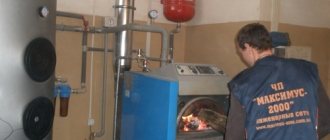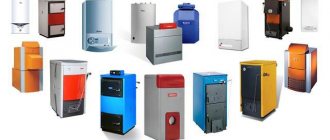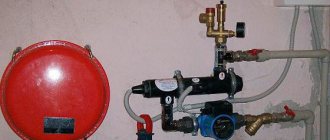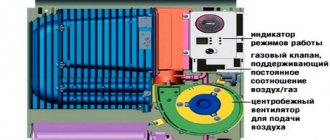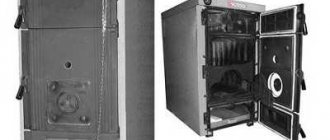How to clean the fire tube heat exchanger of a single-circuit boiler
Cleaning floor-standing boilers with a fire tube heat exchanger differs from the same procedure for mounted equipment. Here, to carry out the procedure, the heat exchanger is not removed, but only access to it is provided.
To complete the work you will need the following tools:
- open-end wrenches;
- metal brush;
- hand brush for metal;
- screwdriver;
- natural bristle brush or nylon brush.
The first mandatory action is to turn off the gas supply valve. Next, you need to complete three stages of work - providing access to the heat exchanger, cleaning parts, and assembling the boiler. The disassembly/assembly steps depend on the specific model. How to clean boilers of the MAYAK-12 KS model can be seen in detail in the video.
Boiler cleaning
When the chimney becomes dirty, as a rule, automatic control systems are activated, notifying residents of problems with smoke removal and the need to clean the system. This is not provided inside the boiler, and you must monitor its contamination yourself so that poisoning from combustion products does not occur and the device continues to function normally.
Before cleaning the boiler, you must turn off the gas and power supply, wait until the boiler has completely cooled down, and then carefully disassemble it. Cleaning can be carried out in two ways - chemical and mechanical.
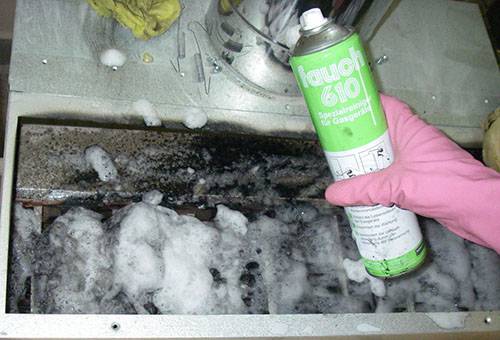
Chemical cleaning
The first option is less dusty and faster. Sulfamic and adipic acids, as well as special gels, are used. But chemicals corrode not only the soot itself, but also the metal of the boiler. This harmful effect can be reduced by diluting cleaning products, but it will not be possible to make them completely safe for metal. This is how it is recommended to clean only small stains that do not require prolonged exposure to the metal.
If, nevertheless, it is decided to use the chemical method for large accumulations of soot, then neat grooves are left on their surface with a brush or scraper, which will help the solvents to better penetrate the soot. The acids are diluted in water and pumped under pressure into the boiler container, then they are washed out with a large amount of water.
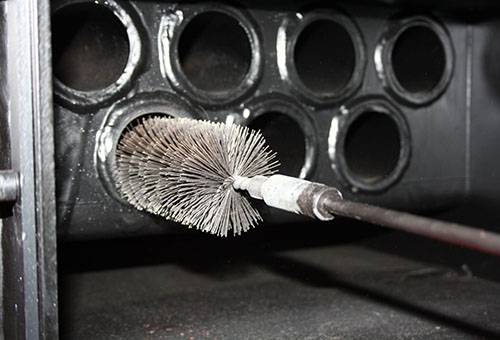
Mechanical cleaning
This cleaning method involves physical separation of soot from the surface.
It is also imperfect - it is a long process, and if handled carelessly, it is also harmful to the boiler. Trying to remove soot, its walls can be severely scratched, which will lead to accelerated corrosion of the metal
To prevent this, choose items for cleaning that do not have sharp corners. Tools for mechanical cleaning of the boiler are often included with it - these are scrapers, wire brushes, and pipe cleaners.
They clean the boiler either simply with brushes, or use various abrasive substances with them. For a thin layer of soot of 1-2 mm, ordinary soda is also suitable.
In addition to soot, cleaning will also remove salts that have settled from the water - scale. This scale must also be removed from time to time by cleaning the boiler heat exchanger, mechanically or chemically. During mechanical cleaning, it is regularly washed with running water, and during chemical cleaning, acids are pre-mixed with water and heated. Gel chemicals do not need to be diluted but are added directly to the cooled heat exchanger. They are slightly less effective, but at the same time less aggressive towards metal.
Filling the boiler with water, boiling it and then draining it will help to significantly reduce the amount of soot. Many boilers also provide air cleaning - there are holes for supplying air under pressure.

Types of cleansing
Gas boiler cleaning can be very different:
- mechanical;
- chemical;
- booster cleaning.
If the blockage from a gas boiler cannot be removed with your own hands, you can invite professionals.

Mechanical cleaning is carried out using various scrapers, brushes and abrasives. This process is very long and complex. Mechanical cleaning of components must be carried out with great care so as not to damage the surface of the parts.
If the layer of soot or soot is not more than 1-2 mm, then it is enough to use ordinary soda for the cleaning agent. Gel substances are not released with high efficiency, but have a gentle effect on metals.
Find out here how to clean a gas boiler burner, its spray device and ignition wick?
Dry cleaning is important for stubborn stains, but they must be used very carefully. Since frequent exposure to aggressive chemicals leads to slow corrosion of the surface. It is necessary to use abrasive chemicals only in diluted form, but even in this case it will not be a completely harmless product.
Booster cleaning is carried out only by specialists. This option is suitable for washing the heat exchanger and is fast and highly efficient. Booster hoses are connected to the boiler nozzles and the reagent is passed through them. The substance enters the supply pipe, and it comes out into the return pipe. Likewise, a chemical is run through the pipes a couple of times through the pipe coil and cleans it out. The waste substance is drained, then water is passed through the system to rinse the circuit.
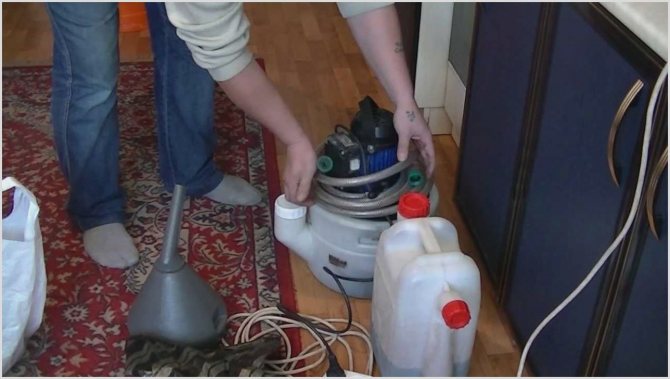
Disassembly and soot removal
For efficient operation of the equipment, it is necessary to clean the gas water heater. The deposits formed on the walls can disrupt the uninterrupted operation of the device, so there is no need to wait for the equipment to completely fail; preventive cleaning should be carried out periodically.
Before dismantling, it is necessary to block access to gas and water. Do-it-yourself cleaning of a gas water heater begins with removing the boiler doors and disconnecting the auto-ignition wire. Then the thermocouple, piezoelectric element and burner tube are removed
Carefully remove the nozzle and the burner itself
The thermometer sleeve, boiler lid, and flue are removed. Cleaning the geyser is done using a brush and brushes, which clean all internal and external elements. The nozzle hole is cleaned with a needle with a smaller diameter to avoid enlarging the hole and disrupting the combustion mode. The internal channels of the heat exchanger are blown out with a vacuum cleaner and wiped with a damp cloth.
At the same time, you can carry out minor repairs to the heat exchanger yourself: replace the gasket under the pilot burner, check the thermocouple, which is prone to breakdowns due to the specifics of its operation, and so on. Such work does not require large investments, but maintains the boiler’s performance at a high level, and the thermocouple device is quite simple, and replacing the element will not be difficult.

Structure of a gas boiler
Assembly is carried out in reverse order. When connecting the piezoelectric element, it is recommended not to use a tool to avoid damaging the ceramic base; it is better to tighten it by hand.
When installing, you need to check the thermocouple on the gas boiler; you need to know that the end of the conductors must be at the level of the place where the flame appears.
Where to begin
Before you start cleaning a gas boiler, it is worth understanding how this equipment is equipped. It contains the following components that require periodic cleaning:
- burner with nozzles;
- igniter;
- heat exchanger;
- gas filter;
- firebox;
- chimney.
Read also Obi catalog of goods for summer cottages Moscow
To clean the equipment, you will need to prepare all the necessary tools:
- plastic or metal brush for cleaning the chimney;
- scrapers;
- steel rope;
- special hooks;
- holders for brushes of various lengths.
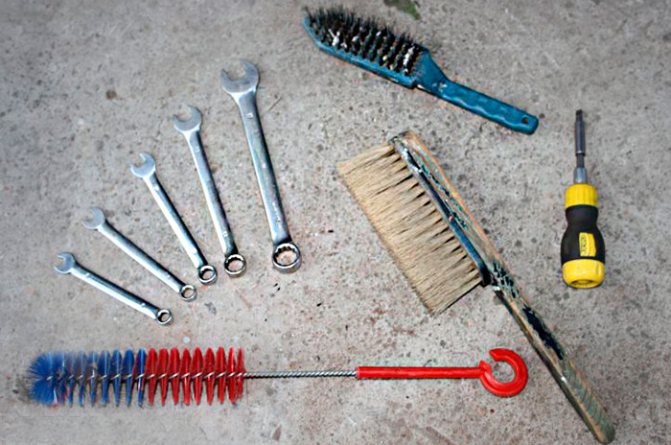
The cleaning process itself will be reduced to the following steps:
- Closing the gas supply valve.
- I dismantle the boiler door, nozzles, and burner tube.
- Removing the top cover of the equipment.
- Removing the insulation sheet.
- Carrying out the dismantling of the chimney.
- Choosing a metal brush.
- Carefully clean the heat exchanger from soot.
- To clean the heat exchanger channels, use a vacuum cleaner.
- Cleaning the walls of the boiler with a scraper and brush and wiping with a rag.
- We clean the chimney using a brush with a long handle.
- Reassemble all boiler components in reverse order.
Attention: when disassembling gas equipment, carefully remember the location of all parts and components.
How to clean individual units of the unit
Let's look at how to clean individual components of the unit if they become clogged and stop working properly.
When the igniter is in normal condition, the flame will have a blue tint. If, during operation of the heating equipment, the flame turns yellow, it’s time to clean the igniter. The procedure for cleaning the igniter boils down to:
- Blocking the flow of gas to the equipment.
- Unscrewing the igniter.
- Thoroughly clean the igniter from soot and dirt with a wire brush.
- Blowing out the igniter.
- Installing it in its original place.
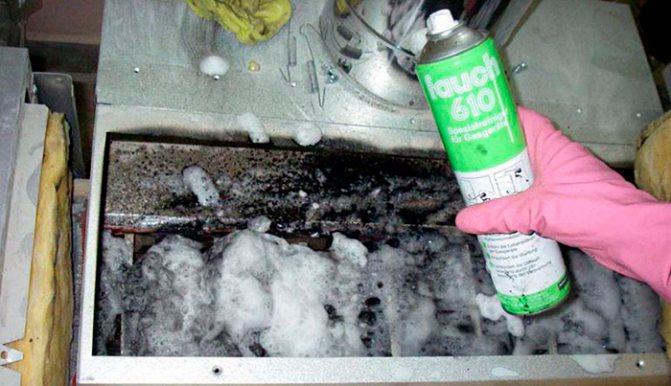
If you need to clean the burner with nozzles, you will need:
- Shut off the gas supply.
- Remove the burner.
- Carefully remember the location of the injectors and carefully unscrew them.
- Clean the injectors with a brush.
- Clean the burner with a brush.
- Blow out the burner hole with pumping equipment.
- Insert the injectors into place.
- Install the burner.
Important : the burner with nozzles must be cleaned at least once a year, before the start of the heating season. The gas filter cleans the gas from impurities and contaminants and must be cleaned regularly.
The heat exchanger can become clogged both inside and outside. Its outer part becomes dirty with soot, and its cleaning is carried out mechanically. To effectively clean the heat exchanger, you will need to stock up on the following tools:
- scraper;
- wire brush;
- ruffs of various shapes;
- power tools and cleaning attachments.
The cleaning procedure boils down to:
- Disconnecting the boiler from electricity and gas supply.
- Removing the heat exchanger.
- Clean it with previously prepared tools.
- Installing the unit in its original place.
Attention : when cleaning the heat exchanger, it is recommended to use a tool without sharp edges. If the unit is damaged, it will lead to corrosion.
The cause of internal clogging of the heat exchanger is most often scale and will require dry cleaning using:
- adipic acid;
- sulfamic acid solution;
- special gel.
Attention : it is necessary to select chemicals depending on the degree of contamination of the heat exchanger.
As for cleaning the firebox and chimney, the collection of soot on their walls reduces the functioning of the boiler, so it is recommended to clean the chimney soot regularly.
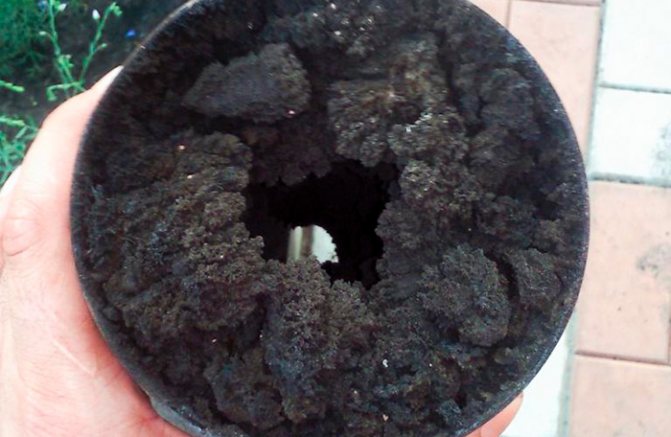
How often should the boiler be cleaned?
The technical documentation for the boiler indicates how often it needs to be serviced. For closed circuits with the addition of reagents (single-circuit heating boilers), cleaning is required less frequently. It can be performed once every 2-3 years. The bithermic and secondary heat exchanger must be washed every year, and under difficult operating conditions (“poor” water composition) – twice a year.
Signs that the boiler urgently needs cleaning:
- the boiler slowly gains temperature;
- insufficient traction;
- the burner does not ignite or burns poorly;
- with the same gas consumption, the heat transfer is less;
- traces of soot or partially burnt paint in the area of the viewing window.
You should not neglect preventive measures, because this can result not only in broken equipment, but also a threat to the safety of all residents of the house. Clogged smoke exhaust ducts and pipes with build-up inside can cause serious accidents.
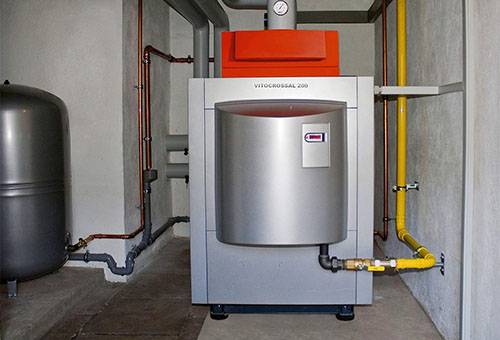
The nuances of cleaning a gas boiler
When starting cleansing you need to know that:
Boilers should be flushed when they are completely disconnected from electricity, gas and water. When dismantling the heat exchanger, you must try not to damage the sealing elements; failure to seal will lead to leaks and breakdown of the unit. Care must be taken when cleaning the heat exchanger; the thin tubes on the inner surface may be damaged. A control check for the tightness of connections can be carried out by coating the joints with a soap solution. When washing, it is recommended to add stabilizers to aggressive solutions. reducing the acidic effect on the metal and forming a protective film on the surface of the element.. It is best to rinse the heat exchanger of a gas boiler with special reagents that will be gentle on the material of the unit and qualitatively remove all contaminants
It is best to rinse the heat exchanger of a gas boiler with special reagents that will be gentle on the material of the unit and efficiently remove all contaminants.
Master Boiler Power - the product removes iron oxide and calcium carbonate deposits, does not affect gaskets and seals, the process is accompanied by active foaming, works at a temperature of 20 - 40 ° C. Cleaning is considered complete when foaming stops.
Zinconex Powder - removes almost all deposits, contains a color indicator that allows you to control the degree of washing. Compatible with aluminum, galvanized, copper, steel and cast iron surfaces.
Fauch 200, Fauch 610 – spray (aerosol) designed to remove soot from the walls of boilers and heat exchangers.
Effective soot remover HANSA - is a mixture of crystals that burn in the firebox when ignited. It is designed to clean boiler and chimney elements from soot and resinous deposits; it reacts with them, destroying the structure of deposits.
Periodically washing the heat exchanger of a gas boiler with your own hands will save costs on electricity, fuel and replacement of expensive parts, and will also extend the life of the unit.
Do-it-yourself booster for washing heat exchangers
clean the gas water heater
heat exchanger for gas boiler
Deposits in boilers - consequences of poor water treatment
Harmful deposits in boilers of heating systems are formed only due to the use of low-quality (untreated) water and they require water treatment. It must be said that water is the only substance widely distributed on the planet that can exist in three states of aggregation - solid, liquid and gaseous. With a uniform increase in temperature, it is able to absorb much more heat than any other substance - during the process of evaporation at normal pressure, it can increase up to 1600 times in volume, turning into hot steam that transfers enormous amounts of heat. It goes without saying that such unique parameters turned water into an ideal raw material resource used for generating power and heating.
Some substances contained in it, for example, magnesium and calcium, are inversely soluble, and as the temperature increases, their solubility decreases even more. Consequently, magnesium and calcium salts, which somehow dissolve at low temperatures and low concentrations, become insoluble when the temperature rises and settle in the form of deposits on the walls of water heating boilers and other equipment; boiler flushing is required here.
BWT solutions for cleaning heat exchangers:
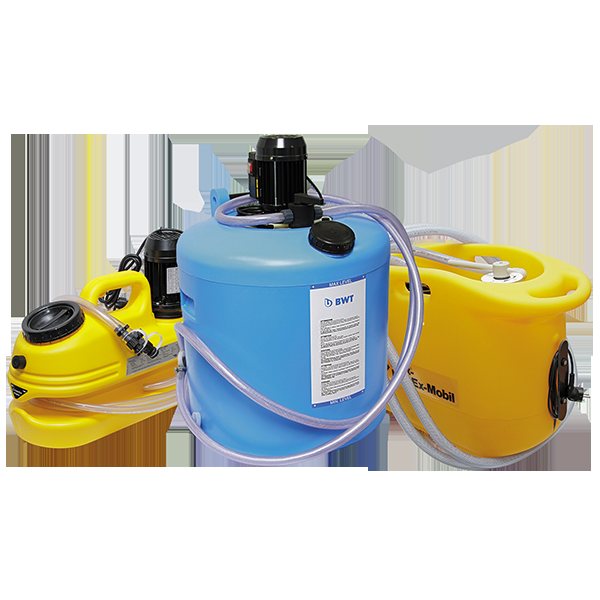
Washing units
Reagents
To get a consultation
Dissolved magnesium and calcium bicarbonates are destroyed under the influence of high temperature, resulting in the release of gases and the appearance of insoluble carbonates, which in the form of deposits settle on the walls of the boiler or form scale in boiling water, which also settles on the metal surfaces of the boiler. When heated, calcium sulfate also becomes practically insoluble, settling on the walls of the boiler in the form of deposits and scale. Together with silica, sulfate is very hard, so removing them is very difficult.
Typically, silica is present in water in small quantities, however, under certain conditions it can cause the formation of very hard deposits. Soluble or suspended iron found in feedwater can also form deposits in boilers . As for oil or other residues from technological processes, they cause the formation of deposits, which, in turn, provoke the appearance of deposits of other impurities. Sodium compounds do not form deposits under optimal conditions - they may appear in pipes with low flow, if porous deposits are present, or in an area of stable steam.
If untreated feed water is used in heating boilers, then as minerals precipitate, a crystalline structure begins to form and then it is necessary to flush the heat exchanger. Typically, deposits are a mixture of several types of minerals, corrosion products, and other contaminants. The most common types of deposits in water heating boilers are calcium silicate or sulfate, carbonates, magnesium silicate or hydroxide, copper and iron oxides, and in some cases silica.
If the feedwater contains large amounts of phosphates, the mud deposits in the boilers will also contain calcium and magnesium phosphates. Typically, phosphate deposits appear in boilers that use chemicals for internal cleaning. Basically, such deposits are soft, they are gray or brown in color, and they are very easily removed by any cleaning methods. We can say that they are the most “preferred” reaction results when phosphate removing reagents are used to prepare water that is too hard. These elements are mainly the predominant ones that are detected during the analysis of deposits in heating boilers.
boiler deposits are mostly in granular form and can be quite porous. Calcium carbonate crystals are large in size, but often combine with smaller particles of other elements to form a uniform and dense deposit. As soon as they get into the acid solution, which usually happens during the process of washing boilers, they immediately begin to foam, releasing a large amount of carbon dioxide. Sulfate deposits are denser and more durable than carbonates, which is explained by their finer crystalline structure.
What is the difference between chemical cleaning and mechanical cleaning?
Gas equipment can be cleaned in the following ways:
- mechanical;
- chemical;
- electric discharge;
- hydrodynamic.
Mechanical cleaning is carried out using various brushes and scrapers using physical force.
The process is quite lengthy and must be carried out with care so as not to damage equipment parts. As a rule, tools for mechanical reading of the unit come with it.
These include: wire brushes, brushes and scrapers.
Mechanical cleaning of the boiler is carried out with brushes and abrasives. If the soot layer is small and is no more than 1-2 mm, you can use simple soda
Please note that when cleaning the boiler, it is necessary to remove not only soot, but also scale from the water. You can clean scale from the heat exchanger mechanically or chemically
Mechanical cleaning involves regular washing of the heat exchanger with running water, and chemical cleaning involves the use of acid mixed with water.
Experts recommend using dry cleaning only for heavily soiled areas - chemicals corrode not only soot, but also metal. Although diluting chemicals with water reduces the harmful effects on the metal, it is impossible to make them completely safe.
How to clean soot from a boiler?
Since soot is a product of the combustion of organic compounds, it is easy to clean with loose abrasives. When the soot has not yet covered the parts with a thick layer, it is quite possible to get by with soda and a hard sponge. If the soot layer exceeds 1 mm, then boiling water will help you. The cauldron is filled with water and brought to a boil. When the boiling water is drained, the soot can be easily cleaned with a wire brush. To clean the boiler from soot that exceeds 2 mm, active measures will be required. It is first necessary to treat the surface with a stiff wire brush. This is necessary so that the bristles of the brush leave their mark on the dirty surface.
Through the furrows formed, the active cleaning agents penetrate into the very depths of the dirt and subsequently successfully dissolve the soot . Do not forget about safety rules and remember that any substance contains unsafe chemical solvents, so carry out all cleaning activities with protective gloves.
Read also How to determine the quality of candied honey
Our company provides a wide range of services for setting up and servicing boiler equipment.
We also clean the boiler firebox to remove soot.
It has been proven in practice that boiler equipment with a clean firebox regenerates more heat and requires repairs less often.
Negative effects of deposits and cleaning frequency
If you do not regularly clean the boiler, negative consequences cannot be avoided. First of all, heat transfer rates decrease. The room will warm up slowly and the heat will spread unevenly. The next disadvantage is that you will need to use more fuel, and costs will increase accordingly.
A solid fuel boiler that is not promptly cleaned of ash, soot and tar will not last very long, since its main elements responsible for high-quality heating will quickly fail.
By regularly cleaning the pyrolysis boiler, you will ensure not only its efficient operation, but also increase its service life.
The frequency of cleaning procedures for a solid fuel boiler depends on the quality of the fuel used.
If you use high-quality firewood, coal, etc., then it will be enough to clean the unit once every 30-40 days. If you use low quality fuel with high humidity, then the boiler must be cleaned at least once every two weeks.
https://youtube.com/watch?v=AzjiVKtEHCY
https://youtube.com/watch?v=AzjiVKtEHCY
You can read about the features of pellet boilers here.
Dry cleaning
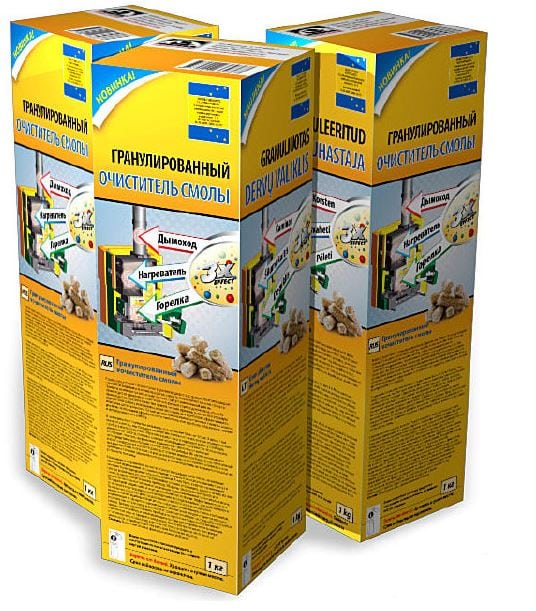
The comfort of the owners of a private home, especially in winter, directly depends on the serviceability of the heating system, and the flawless operation of the heating boiler is guaranteed only if all its parts are kept in perfect order. Sometimes the functioning of equipment is disrupted for a very trivial reason - due to contamination of some parts, for example, a gas water heater or a heat exchanger. Let's consider whether it is possible to clean a gas boiler on your own and whether it is safe.
Pipes through which hot liquid circulates sooner or later become coated on the inside. This process is reminiscent of the deposition of lime on the walls of a kettle: the thicker the layer of scale, the slower it heats up. Salt deposits on the walls of the heat exchanger can cause problems.
This is what heat exchanger pipes clogged with scale will look like (sectional view) if preventive maintenance and cleaning of internal channels are not carried out regularly
Are these troubles really that big? See what awaits you if you do not flush the lines in a timely manner:
- Overheat.
The gas boiler is designed in such a way that the coolant, during the reverse movement, must cool the internal parts of the heating elements. Limescale deposits interfere with proper cooling, so the equipment can break down at any time. - Breakage of important parts.
For example, a narrowing of the pipe diameter leads to an increase in the maximum load on the circulation pump, as a result of which it can also fail. - Increased fuel consumption.
Due to deposits, the thermal conductivity of the pipes decreases sharply, and more energy is required to heat the liquid as required, that is, gas consumption increases. Accordingly, the costs of operating a gas boiler will also increase.
To avoid these troubles, it is necessary to wash regularly.
The frequency of the procedure depends on the liquid that is used as a coolant. Suppose a heating system using antifreeze requires cleaning approximately once every 2 years, while you need to monitor the quality of the liquid and, if necessary, completely replace it. Pipes in which purified water circulates should be washed once every 3-4 years. The higher the hardness of the liquid, the more frequent the cleaning measures.
How to clean a burner with nozzles
The burner is the most important part; it must be perfectly clean, otherwise there will be no fuel savings. This applies to any type of boiler: wall-mounted or floor-mounted.
- the gas supply must be shut off;
- the burner is removed from the boiler;
- unscrew the nozzle (it’s convenient to take a photo before doing this so you know how to put the nozzle back);
- The nozzle is carefully cleaned with a soft brush;
- The burner is cleaned with a brush;
- The burner holes are purged with any pump (regular bicycle or car);
- the nozzle is inserted back into the burner (do not confuse its location);
- The burner and nozzle are put in place.
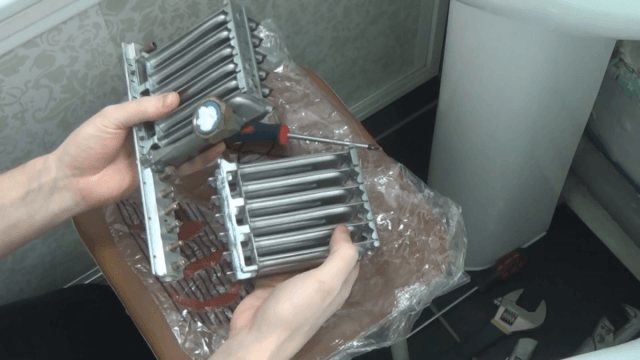
Mechanical cleaning of plate heat exchangers
You can clean the boiler from soot without removing the heat exchanger. To do this, just remove the cover, arm yourself with a stiff nylon brush and close the gas injectors so that dirt does not get in there. The whole process is clearly shown in the video:
If soot has stuck to the surface and is not removed by mechanical treatment with a brush, then the heat exchanger is removed and soaked in special cleaning solutions for several hours. Such products are available for sale in a wide range, examples include Fauch and MAZBIT+ products. But you can also use household chemicals - gels for cleaning grills and ovens.
Before disassembling the boiler, you need to disconnect it from gas and the igniter from electricity. In addition, it is necessary to drain the water from both circuits and the expansion tank. The secondary heat exchanger is removed first; it is located immediately behind the boiler lid. The primary (main) one is more problematic to remove, since you will have to disassemble the combustion chamber.
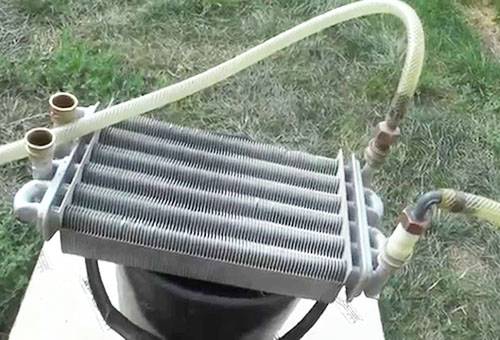
How to clean interior surfaces
Washing the inner surface of a plate, fire tube or bithermal heat exchanger is possible only with the help of special equipment.
- High pressure pump – hydrodynamic flushing. Used to remove small deposits. Advantages are the speed of the procedure and the ability to clean without removing the heat exchanger.
- Booster (acid-resistant pump) – acid (chemical) flushing. Removes even old scale. Advantages – removes scale that cannot be removed by other methods. Disadvantages - if the reagents (acids and neutralizers) are selected incorrectly, it reduces the service life of the heat exchanger.
- Complex "Streamer" for electric discharge cleaning. Used to remove scale of any strength. Advantages - the metal of the heat exchanger is not destroyed, a high degree of cleaning is ensured. Disadvantages: noise and duration of the procedure.
Of all the methods listed above, only chemical cleaning is possible at home, since the factory booster can be replaced with a low-pressure pump. The rest of the equipment is both expensive and voluminous, so such boiler washing can only be carried out by service centers.
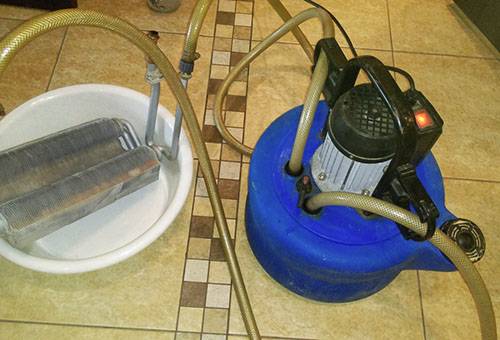
How to clean a gas boiler: procedure for each unit and do-it-yourself cleaning video
An indispensable attribute of any heating system is a boiler, which acts as a heat generator for heating the home.
The modern heating equipment market is saturated with a very wide range of boiler units of various types. But gas boilers occupy a special place in this range. which are gaining more and more popularity every day.
This trend is due to the fact that units of this type are very effective and economical devices for heating a country house or even an apartment. In order for a gas boiler to function smoothly and stably, it is necessary to properly care for it.
One type of such maintenance is cleaning the gas boiler from soot and other contaminants. Let's talk in more detail about why to clean a gas unit, as well as in what ways this can be done.
How often and what parts need to be cleaned
The equipment needs external and internal cleaning. How often should a heat exchanger be descaled? Experts recommend doing this once a year. What other components of the floor-standing and wall-mounted boiler need to be cleaned:
- burner;
- igniter;
- filters;
- nozzles;
- coaxial chimney, conventional shaft;
- pipes;
- firebox
Let's look at how to properly clean components in boilers "", "", "" and others with your own hands.
Heat exchanger
The operation of all double-circuit boilers is controlled by a three-way valve. It switches heat from one radiator to another, so you need to monitor its functionality.
The principle of cleaning it and the choice of a suitable product depend on the structure of the heat exchanger. Radiators are distinguished:
- Bithermal. The design consists of two tubes, heating is carried out simultaneously for DHW and heating. Such products are difficult to clean;
- Lamellar. Consist of layers of plates;
- Fire tubes. Liquid circulates through the coil tube. More often found in floor-standing units "", "", "".
What kind of washing happens:
- Chemical;
- Mechanical;
- Hydrodynamic;
- Electric discharge.
To work you will need:
- wrench;
- brush-brush;
- metal brush, made of lint;
- screwdriver.
First you need to get to the node.
- Close the gas valve;
- Remove the cover. This may require unscrewing the bolts;
- Disconnect the sensors connected to the heat exchanger.
For proper cleaning, the unit must be dismantled. Using a brush and brush, clean the surface and internal parts from soot, dust, and soot. If descaling of internal parts is required, chemical reagents can be used.
The reagent is pumped into the booster. The pump hoses are connected to the radiator, and flushing starts. Upon completion, all parts are washed with clean water. Users recommend using ordinary household products - they are much cheaper than specialized ones. The main thing is that they are thick.
You can use home remedies. Prepare a solution of citric acid in a ratio of 200 grams per 5 liters and pour it into the heat exchanger. Place the knot in a metal basin of water and place it on the stove to heat for half an hour. Then rinse in the shower.
Plates and parts should not be subjected to strong mechanical stress, otherwise they will deteriorate or become deformed.
Hydrodynamic cleaning consists of pumping pressure. Thus, a high-pressure stream is forced through the system, removing contaminants and deposits.
The electric discharge procedure requires special Streamer equipment, so it is carried out in a service center or workshop. At home, contamination can only be eliminated mechanically or chemically.
Igniter
How do you know when it's time to clean the system? Watch the flame. If everything is in order, it is an even blue color. If the flame is yellow and burns unevenly, it means that the burner and igniter are clogged with dust and soot.
To remove contaminants, do this:
- Shut off the fuel supply;
- Remove the igniter;
- Clean the element with a brush;
- Reinstall the part.
Burner
The degree of contamination can be determined by the signs indicated above.
- After shutting off the gas, remove the burner and nozzles;
- Clean the injectors with a small brush;
- The burner is cleaned with a brush, the inside is purged with a pump;
- Reassemble the parts and install them back.
Filters
Water filter meshes are removed and washed with running water. Rusty deposits can be removed with citric acid - just soak the part in the solution. Don't forget to clean gas filters.
Firebox, chimney
The accumulation of soot narrows the shaft passage, which leads to poor traction. In this case, the boiler cannot be operated - it is life-threatening. You can remove the soot from your side, and contact the utility company for cleaning from the street. Make sure that the top of the chimney is not covered with ice. To avoid this, it is better to insulate the pipe.
The firebox is cleaned with brushes. Carefully monitor the amount of soot. Under unfavorable conditions it may catch fire.
A long service life cannot but affect the performance of the boiler. Scales and all kinds of deposits on internal parts reduce heat transfer and increase energy consumption. These factors significantly reduce the functional resources of the boiler. Regular checks and timely maintenance help prevent serious damage and determine whether cleaning is required. We can say with complete confidence that timely cleaning of gas boilers from soot is a guarantee of uninterrupted operation of the units. During the cleaning process of gas boilers, deposits, scale, soot, carbon deposits and deposited salt seals on the internal elements are removed. How to clean a gas boiler? To do this, you can invite qualified craftsmen, or you can do it yourself. If you are confident that you are up to the task, get started.
